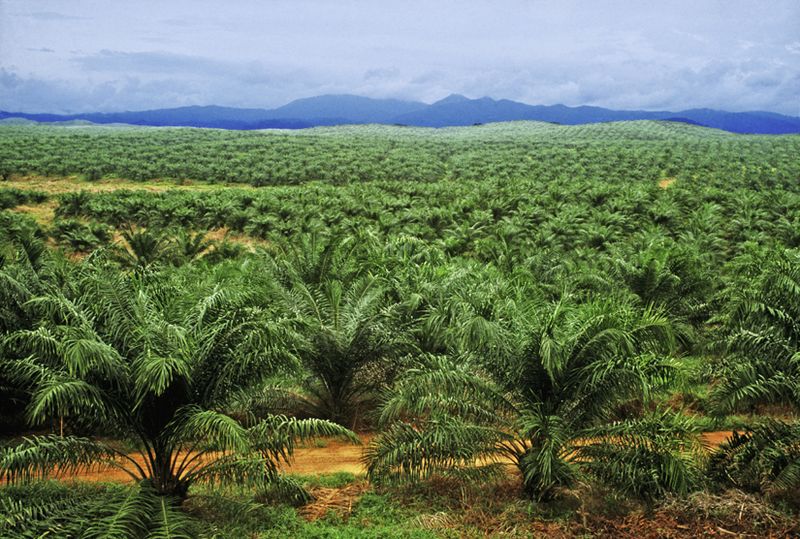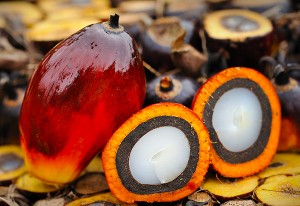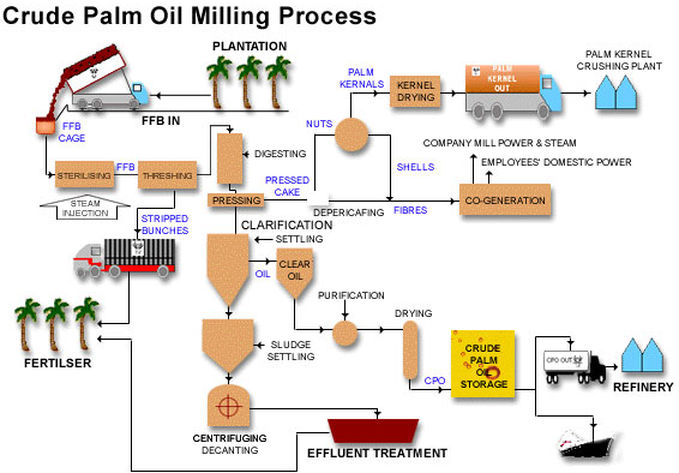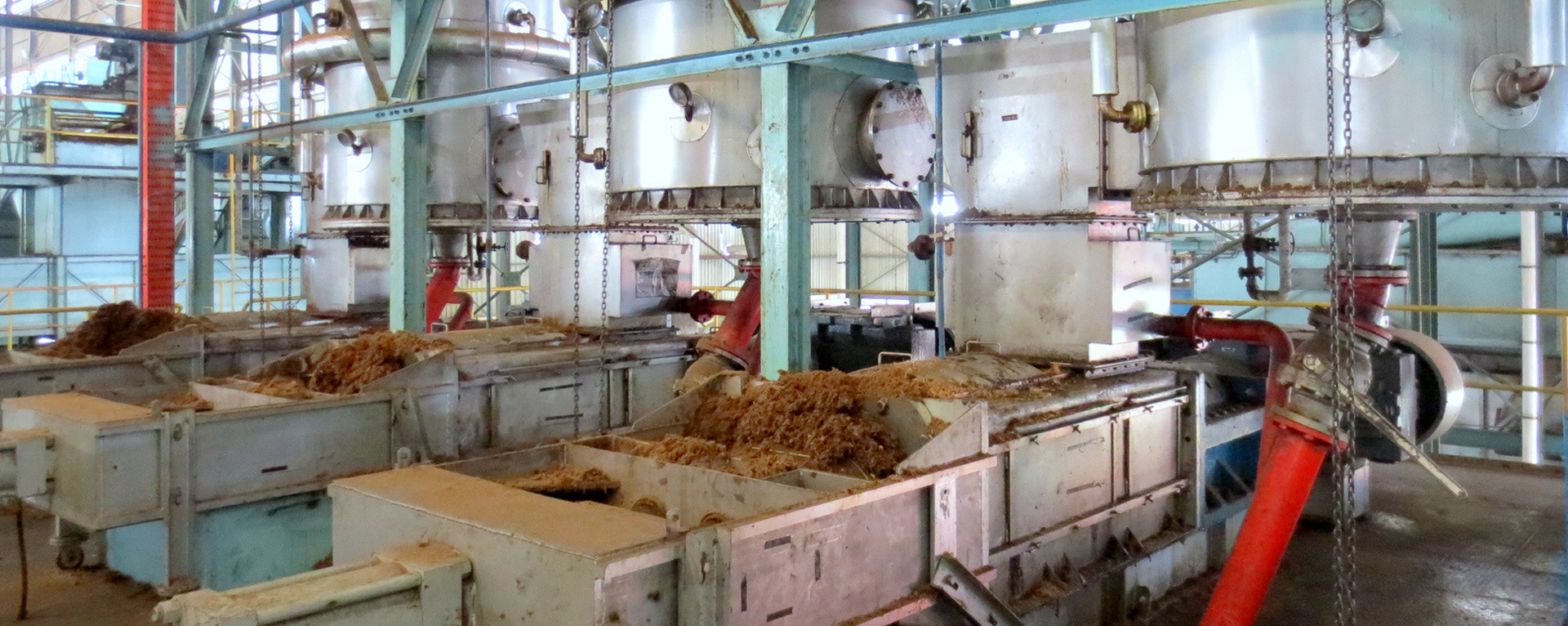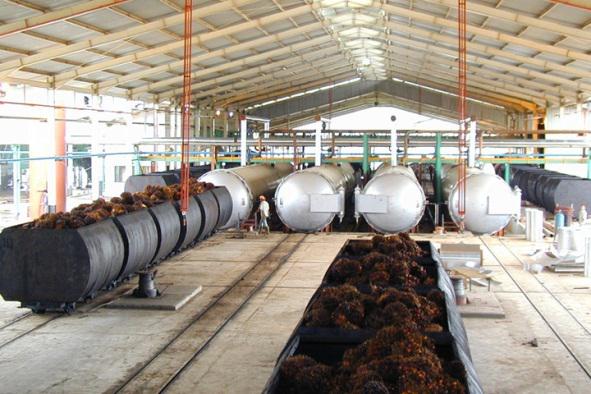Palm Oil
Palm oil (also known as dendê oil, from Portuguese) is an edible vegetable oil derived from the mesocarp (reddish pulp) of the fruit of the oil palms, primarily the African oil palm Elaeis guineensis, and to a lesser extent from the American oil palm Elaeis oleifera and the maripa palm Attalea maripa.
Palm oil is naturally reddish in color because of a high beta-carotene content. It is not to be confused with palm kernel oil derived from the kernel of the same fruit, or coconut oil derived from the kernel of the coconut palm (Cocos nucifera). The differences are in color (raw palm kernel oil lacks carotenoids and is not red), and in saturated fat content: palm mesocarp oil is 41% saturated, while palm kernel oil and coconut oil are 81% and 86% saturated fats, respectively.
Along with coconut oil, palm oil is one of the few highly saturated vegetable fats and is semi-solid at room temperature. Like most plant-based products, palm oil contains very little cholesterol.
Palm oil is a common cooking ingredient in the tropical belt of Africa, Southeast Asia and parts of Brazil. Its use in the commercial food industry in other parts of the world is widespread because of its lower cost and the high oxidative stability (saturation) of the refined product when used for frying.
The use of palm oil in food products has attracted the concern of environmental activist groups; the high oil yield of the trees has encouraged wider cultivation, leading to the clearing of forests in parts of Indonesia in order to make space for oil-palm monoculture. This has resulted in significant acreage losses of the natural habitat of the orangutan, of which both species are endangered; one species in particular, the Sumatran orangutan, has been listed as critically endangered. In 2004, an industry group called the Roundtable on Sustainable Palm Oil (RSPO) was formed to work with the palm oil industry to address these concerns. Additionally, in 1992, in response to concerns about deforestation, the Malaysian Government pledged to limit the expansion of palm oil plantations by retaining a minimum of half the nation’s land as forest cover.
Palm Oil Production
In 2012, the annual revenue received by Indonesia and Malaysia together, the top two producers of palm oil, was $40 billion. Between 1962 and 1982 global exports of palm oil increased from around half a million to 2.4 million tonnes annually and in 2008 world production of palm oil and palm kernel oil amounted to 48 million tonnes. According to FAO forecasts by 2020 the global demand for palm oil will double, and triple by 2050.
Palm Oil in Indonesia
Indonesia is the worlds largest producer of palm oil, surpassing Malaysia in 2006, producing more than 20.9 million tonnes. Indonesia expects to double production by the end of 2030. At the end of 2010, 60% of the Indonesian palm oil output was exported in the form of crude palm oil. FAO data show production increased by over 400% between 1994 and 2004, to over 8.66 million metric tonnes.
Palm Oil in Malaysia
In 2012, Malaysia, the world’s second largest producer of palm oil, produced 18.79 million tonnes of crude palm oil on roughly 5,000,000 hectares (19,000 sq mi) of land. Though Indonesia produces more palm oil, Malaysia is the world’s largest exporter of palm oil having exported 18 million tonnes of palm oil products in 2011. China, Pakistan, the European Union, India and the United States are the primary importers of Malaysian palm oil products.
Palm Oil in Thailand
In 2013, Thailand produced 2.0 million tonnes of crude palm oil on roughly 626 thousand hectares. Thailand expects to produce 11 million tonnes of fresh palm nuts in 2016, down from more than 12 million in 2015, the shortfall due to Thailand’s drought.
The Global Palm Oil Market
According to the Hamburg-based Oil World trade journal, in 2008 global production of oils and fats stood at 160 million tonnes. Palm oil and palm kernel oil were jointly the largest contributor, accounting for 48 million tonnes, or 30% of the total output. Soybean oil came in second with 37 million tonnes (23%). About 38% of the oils and fats produced in the world were shipped across oceans. Of the 60.3 million tonnes of oils and fats exported around the world, palm oil and palm kernel oil made up close to 60%; Malaysia, with 45% of the market share, dominated the palm oil trade.
Introduction to Oil Palms Plantations
The oil palm crop is one of the highest oil (palm oil) yielding crops among the all perennial crops. Oil palm tree produces edible palm-oil as well as palm kernel-oil. This oil palm is considered as golden palm due to its high yielding capacity. The Oil palm tree belongs to the family of “Arecaceae” and genus of “Elaeis”. In India, oil palm crop provides the excellent substitute of importing the oil. In India, oil palm is cultivated in more than 15 states by covering about 50,000 hectares under irrigated conditions and this crop also cultivated under rain fed conditions.
Advantages of Oil Palm Cultivation The following are the advantages and benefits of the oil palm cultivation.
- Oil palm yields highest edible oil among the other oil crops. The yield of 4 to 5 tonnes/ha can be expected.
- Oil palm crop is a hardy crop and low pest and disease incidence.
- Farmers can get extra income by intercropping in pre-bearing period of oil palms.
- There is no risk of theft and provides local employment.
- This crop assures monthly income and good market price throughout the year
- Farmers can expect high returns which results in uplift of economic status.
- Palm oil substitutes import of edible oil by saving valuable foreign exchange.
Climate Requirement for Oil Palm Cultivation
Oil palm is a humid tropical crop and thrives best in the areas where temperature ranges from 22°C to 24°C (minimum) and 20°C to 33°C (maximum). Oil palms require at least 5 to 6 hours of bright sunshine per day and 80% of humidity for optimum growth. This crop requires annual evenly distributed rainfall of 2500 to 4000 mm or 150 to 150 mm monthly. As Indian climate is not suitable for evenly distribution of the rain, farmers are advised to go for assured irrigated conditions for oil palm cultivation.
Soil Requirement for Oil Palm Cultivation
Generally, oil palms can be grown on wide range of soils. However, they thrive best in well- drained deep loamy moist and alluvial soils rich in organic matter. These trees require at least 1 meter soil depth. Farmers should avoid highly saline, highly alkaline, coastal sandy and water stagnation soils.
Propagation of Oil Palms
The Propagation in oil palm cultivation is mainly by seeds and seeds are extracted from fruits using depericarper. Pre-heating of seeds is required for 75 days at 40°C temperature due to their high dormancy. Thereafter, seeds should be soaked in running water and make them to cool down for 4 to 5 days. The seeds start germinating if 10 to 12 days and once germinated, sprouts should be transplanted to poly bags. In nursery raising, the single stage poly bag system is a very popular propagation method and in this process, a poly bag size 40 35 should be filled with top soil, sand and well rotten manure. Then sprouts should be placed at a depth of 2.5 cm in the center of the poly bag. Regular watering and mulching should be carried for proper growth of seedlings. Use recommended NPK in nursery until they are transferred to the main filed.
Land Preparation, Spacing and Planting
Land should be made weed free and couple of ploughings should be given to get the soil fine tilth stage. Supplement the field with good organic matter to make the soil rich field. The best season for oil palm planting is from June to December. However, crops grown during summer should be provided with sufficient irrigation, mulching and growing cover crops in the tree basin is preferred to avoid hot winds in summer season. Healthy Seedling of 12 to 15 months age old with at least 1 meter height and 12 to 13 functional leaves are recommended in the oil palm tree cultivation. In triangular planting method, with a spacing of 9 meter x 9 meter x 9 meters, 143 to 145 oil palm plants can be accommodated in 1 hectare land. Planting should be done in the pits with size of 60 cm x 60 cm x 60 cm. Mix the soil with 400 grams of single super phosphate and 50 grams of phorate and apply at base of the pit as soon as planting is done. Do not forget giving irrigation immediately after the fertilizers applied at the base of the pit.
Intercropping Oil Palms
Oil palms are a wide spaced perennial trees and inter space can be utilized for intercropping during initial 3 year period. Thereafter, shade loving crops can be grown. The care should be taken with inter¬crops so that it will not compete with oil palms in terms of water, light and nutrients. The most suitable inter-crops during initial 3 year period are any vegetables, flowers, chillies, banana, tobacco, ginger, turmeric, pineapple. As part of the inter-crop process, should not cut the oil palm fronds or tie oil palm fronds close to the stem. Ploughing close to palm base should be avoided as it may cut the palm roots. For better yield maximum number of green leaves should be retained.
Irrigation Requirements for Oil Palms
Oil palm crop requires sufficient irrigation as its growth rate is faster and produces high yield and biomass. Farmers are advised not to grow this crop in the regions where assured and sufficient irrigation is not available. Each growing plant requires about 200 liters of water per day. Older plants require little bit more in hot summer season.
Drip irrigation or Micro sprinklers: This system can be adopted in the undulated terrain land,if the water is a main constraint. In case of drip irrigation method, each palm requires 4 dippers at the base. With 4 dippers ejecting 32 liters of water for five hours per day is enough to cover the 160 liter requirement per day/palm. In case of micro sprinklers (180° or 360 °), each on either side of the palm can be installed. In case of adopting these irrigation methods, check the drippers or sprinklers regularly for proper discharge. Practice mulching to retain the moisture at the base.
Basin Method of Irrigation: This can be practiced when there is a abundant irrigation water is available. In this case, irrigation channels should be prepared to connect the individual palms separately by sub-channel .Usually required water should be given at 4 to 5 days interval. In case of heavy soils, irrigation interval would be longer and in the lighter soils, frequent irrigation with less water quality should be provided.
Mulching Oil Palms
Mulching can be carried out to conserve the soil moisture and control the weed growth. Mulching can be done with dried leaves, coconut husk, male flowers and empty bunches.
Oil Palm Pollination
The oil palm is a highly cross-pollinated crop in which the insects and wind assist pollination However wind pollination is not sufficient and the insects like “Elaeidobii is kamerunicus” assists in good fruit set and effective pollination. This weevil should be released after two and half year of planting and in case of low vigour and girth plantation, releasing the weevils after three years is advisable.
Weed Control
Regular manual weeding or chemical weeding can be carried out in oil palm cultivation. However, chemical weeding should be done only with recommended herbicides. For effective control of weeds, Glyphosate of 700-750 ml/ha/year or 17 ml/basin should be applied. By spraying herbicide mixtures of Paraquat with Atrazine, Diuron and Monuron on ground can effectively control the weeds and this operation should be carried out twice a year.
Flowering and Ablation
Oil palm trees start flowering in 14 to 18 months after planting the crop. Oil palm tree produces both male and female flowers separately on the same palm tree. The process of removing male and female flowers in early stages of oil palm plantation is called “ablation”. Ablation is required in oil palm cultivation for development of stem girth, vigour and string root system. Flowers should be removed manually or with recommended tool as soon as inflorescences appear on the oil palm tree. This process can be extended up to 2 to 3 years depending on the tree vigour and growth.
Basin Management
As part of the basin management practice in the oil palm cultivation, basins of 1 meter radius, second year 2 meter radius, and the third year 3 meter radius should be made by removing the soil inside so that soil accumulation can be prevented in the collar region of the palm. For healthy roots, basins should be weed free and clean.
Manures and Fertilizers
Oil palms require a balanced and sufficient supply of micro, macro and secondary nutrients for high production of palm oil. In oil palm cultivation, fertilizers should be applied at every 3 months interval. Starting from the June or July, 4 equal split doses of fertilizer should be applied at 3 months interval. In case of newly planted trees, first dose of fertilizers should be applied after 3 months of planting. Farm yard manure (FMY) of 75 to 100 kg or 90 to 100 kg of green manure and 5 kg neem cake should be added per each oil palm tree along with 2nd dose of fertilizers. These fertilizers should be applied in the soil with the help of field fork at least 40 to 50 cm away from the palm base. Do not forget watering the palm trees after fertilization.
Pests and Diseases
The following are the common pests and diseases are found in oil palm cultivation: Pestalotiopsis leaf spot, Ganoderma butt rot, Bacterial bud rot, Oil palm wilt, Rhinoceros beetle, Mealy bugs. Appropriate control measures should be taken care for these pests and diseases by contacting nearest agriculture department.
Harvesting Oil Palms
The oil palms will be ready for harvesting in 2.5 to 3 years after the plantation in the main field. Determining harvesting time is very important in oil palm cultivation as it greatly impacts the quality and quantity of oil. Harvesting can be done when the fruits on palm turn into yellowish – orange colour and 5 to 8 fruits drop on their own. The final check would be when pressing the fruits hard with finger, orange coloured oil should extrude from the palm fruits. Harvesting takes place throughout the year and generally done in 10 to 14 days interval with the help of sharp knife or sickle. A stalk length of 5 cm should be left while harvesting the fruit bunches.
To find out more about how Plantations International can assist you with the development and management of your oil palm plantation and to receive a free initial consultation, please call us today on +852 5808 3775 or Click Here to contact your nearest Plantations International representative.

